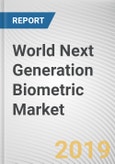To enable an in-depth analysis, the global new generation biometrics market is segmented based on technology, applications and geography. The global biometric application market is categorised into various applications namely border security, healthcare, commercial security, banking and finance, travel and immigration and defence. Different technologies used for human identification are palm, fingerprints, signature, iris, vein and DNA. Analysis is carried out across different regions, namely, North America, Europe, APAC and LAMEA. Fingerprint recognition is the most widely used technology followed by face and iris recognition. Travel and immigration is the application that generates the highest revenue. It is succeeded by government and defence. North America is the global leader in new generation biometrics, followed by Europe and APAC.
Key Benefits
The report showcases current and future trends in the global new generation biometrics market to elucidate the imminent investment pockets in the market
Segmentation of the global new generation biometrics market provides an in-depth analysis of applications and end users in different regions
Drivers & opportunities are examined to identify the current factors which are responsible for market growth and upcoming technologies that would boost market growth in the future
Current and future trends are charted to determine the overall attractiveness of the market
The report provides details about top competitors and their winning strategies
Quantitative analysis of the current market and estimations through 2013-2020 would determine the financial caliber of the market
KEY MARKET SEGMENTS
The global new generation biometrics market is segmented based on technology, applications and regions.
MARKET BY TECHNOLOGY
Fingerprint
Face
Iris
Vein
Palm
Voice
Signature
MARKET BY APPLICATION
Government
Travel & Immigration
Defence
Home Security
Consumer Electronics
Banking and Finance
MARKET BY GEOGRAPHY
North America
Europe
Asia-Pacific
LAMEA
Methodology
The analyst offers exhaustive research and analysis based on a wide variety of factual inputs, which largely include interviews with industry participants, reliable statistics, and regional intelligence. The in-house industry experts play an instrumental role in designing analytic tools and models, tailored to the requirements of a particular industry segment. The primary research efforts include reaching out participants through mail, tele-conversations, referrals, professional networks, and face-to-face interactions.
They are also in professional corporate relations with various companies that allow them greater flexibility for reaching out to industry participants and commentators for interviews and discussions.
They also refer to a broad array of industry sources for their secondary research, which typically include; however, not limited to:
- Company SEC filings, annual reports, company websites, broker & financial reports, and investor presentations for competitive scenario and shape of the industry
- Scientific and technical writings for product information and related preemptions
- Regional government and statistical databases for macro analysis
- Authentic news articles and other related releases for market evaluation
- Internal and external proprietary databases, key market indicators, and relevant press releases for market estimates and forecast
Furthermore, the accuracy of the data will be analyzed and validated by conducting additional primaries with various industry experts and KOLs. They also provide robust post-sales support to clients.

LOADING...








